I was invited to the tournament in Chennai (India, November 5-11) rather late – at the beginning of September – through my Global Chess League team captain, Srinath Naranayan. We talked about it within my team, and figured there were quite a few advantages to accepting. I was in a good frame of mind in general, and wanted to play more Classical games at the end of the year. Of course, I was also hoping to regain a few Elo points and, in the event of a miracle, play my tiny chance at the Circuit Fide. The list of participants was also interesting, since apart from Levon (Aronian), a client against whom I’d played hundreds of games, I’d met very few of the other players. In particular, I could see that, for example, I’d never played with white against Sarana, not even in a blitz game!
It was therefore an opportunity to meet the younger generation, because Gukesh, Prag or Abdussatorov, even if they are part of it, are first and foremost Elite players. Sarana, Maghsoodloo and Tabatabaei, on the other hand, are fairly young players whom I won’t be playing much in the near future, especially as they haven’t (yet?) qualified for the Grand Chess Tour.
I arrived a few days early in South India to try and get into shape and avoid jet lag. But it’s true that I felt tired even before the tournament started, because I played a lot in August, September and October. I also felt weary during a training camp before leaving for India. I may have underestimated the physical and mental load I was carrying. In hindsight, I understand that I didn’t arrive in Chennai having fully recovered from those three months…
Small glimmer of hope at the drawing of lots though, as I picked rather favorable pairings for once, with four whites and three blacks. And black in particular against the highest rated in the field, Levon and Erigaisi, the rising terror who was very close to 2,800 and whom I’d just met in the final of the WR Masters in London. So I thought this was my chance to be solid with black and seize the opportunities with white.
Things went very well at the start, as I was able to beat Maghsoodloo thanks to a rather nice preparation cooked for me by my trainers. Faced with numerous problems and running out of time, the Iranian player was unable to defend the position. Then, a fairly easy draw with black against Aravindh, another Indian player I didn’t know very well either, who won the tournament and climbed to 2718 Elo!
So far, the tournament was going pretty well. Plus, I was doubling white in the following rounds, so I thought this was my opportunity to win at least one of the two games. And that’s when things went off the rails 😊.
I have to say that Tabatabaei played an absolutely perfect game, including some really difficult moves. At one point, I failed to recognize the latent danger in the position and found myself in trouble. It was a real setback for me, especially as it brought my unbeaten streak to an end at 72 Classical games!
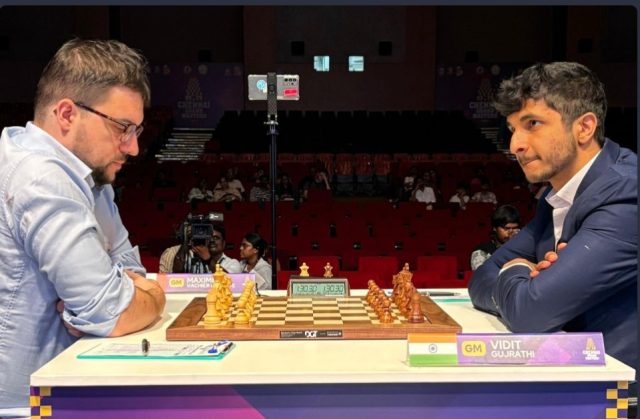
The next day against Vidit, I decided to avoid the Berlin, and we ended up in a closed Catalan that I hadn’t necessarily anticipated. But as the game went on, it got more complicated and I had my chances. Unfortunately, I took a wrong turn and ended up having to fight hard to draw a tricky Rook endgame. Then, I have to say that I played a real non-game against Levon, accumulating an opening improvisation and some unfortunate errors in the beginning of the middle game. Levon was precise in the conversion and calculation of lines to earn the full point.
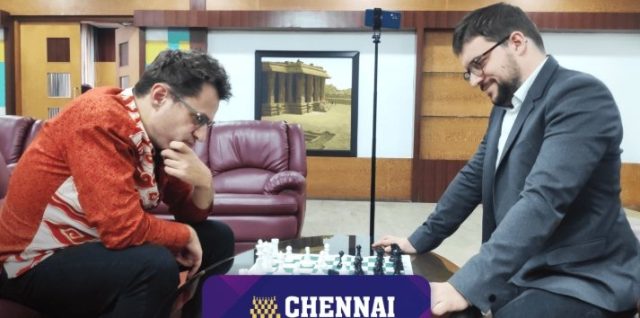
At 2 out of 5 with two rounds to go, it goes without saying that things weren’t going well any more! After an insipid draw against Sarana, I at least had the pleasure of playing a pretty crazy last-round game against Erigaisi, so I’ve chosen to analyze it in full below.
-1 in the end (3/7), it’s clearly not satisfactory, with one very bad game out of the seven, and a few other uneventful ones. In my defense, I struggled during the tournament to find my form.
A word about the playing conditions in Chennai, which were very pleasant. There’s a real chess boom in India and it’s really showing, especially in the number of fans attending!
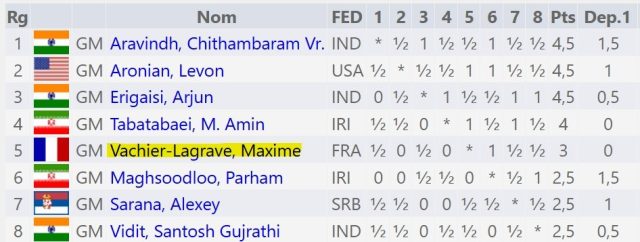
Now I have to get ready to get back in the saddle, as there are two big end-of-year objectives.
First of all, the 2024 Champions Chess Tour Final in Oslo (December 17-21), followed by the Rapid & Blitz World Championship in New-York (December 26-31).
The idea is that I’ve got almost a month to prepare for these two events. And the stated aim is to win one of the three!
Erigaisi – Mvl
Chennai, Ronde 7
1.d4 Nf6 2.c4 g6 3.Nc3 d5 4.Qb3 dxc4 5.Qxc4 Be6 6.Qb5+ Bd7 7.Qb3 c5 8.d5 b5 [Erigaisi managed to surprise me with this rather marginal line against the Grünfeld. Here, I only knew 9. Nxb5]
9.e4!?
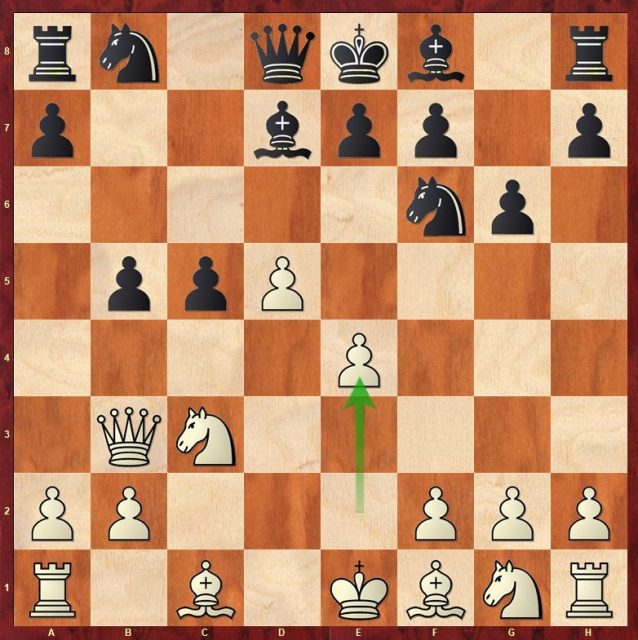
9…b4 [Better was 9…c4! 10.Bxc4 bxc4 11.Qb7 Qb6 12.Qxa8 Ng4! (on the board, I only saw 12…Bg7? 13.Be3 Qxb2 14.Rb1 Qxc3+ 15.Bd2+-) 13.Nge2 (13.Nh3? Bg7 and the action of the Bishop on the long diagonal changes everything) 13…Bg7 14.0-0 0-0 15.h3 Na6 16.Qxf8+ Kxf8 17.hxg4 Bxg4 and all is well for black]
10.e5 bxc3 [10…Ng4 11.e6 didn’t really appeal to me during the game, even if the machine disapproves. Besides, I’m more used to…bxc3/exf6 transactions in the Grünfeld!]
11.exf6 Qb6
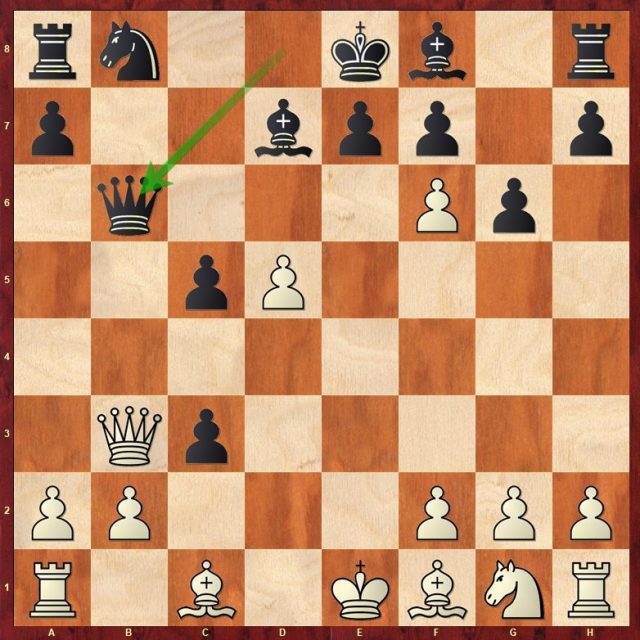
12.Ne2 [Here, Erigaisi thought for a very long time, and opted for a really interesting move. Of course, I was mostly expecting 12.Qxc3 exf6 13.Nf3 and my intention here was 13…c4 (13…Bg7 14.Qe3+ Kd8 15.Qc3) 14.Be3 Bb4 15.Bxb6 Bxc3+ 16.bxc3 axb6 17.Bxc4 0-0 with hopes of compensation for the pawn; 12.bxc3 was quite possible too]
12…Qxf6 [I also looked at 12…cxb2 13.Bxb2 exf6 14.Qxb6 axb6 15.Bxf6 Rg8 16.Nc3 but here I didn’t find a satisfactory move: indeed, 16…Bf5? (yet 16…Be7! 17.Bxe7 Kxe7 18.Rb1 Bf5 19.Rxb6 Nd7 followed by 20… Rgb8 certainly gave enough play for the pawn, which I didn’t realize during the game) 17.Bb5+ Nd7 18.0-0 doesn’t work at all!]
13.Nxc3 Bg7 14.Be2 [I was thinking 14.Bc4 0-0 15.0-0, but here black has 15…Bf5! unlike in the game!]
14…0-0 15.0-0 Bc8 [I wanted to make 15…Bf5 work but after 16.Qb7 Nd7 17.g4 (the reason behind 14.Be2!) 17…Bxg4 (17…Rfb8 18.Qc6) 18.Bxg4 Ne5 19.Be2 it doesn’t work, e.g. 19…Rfb8 20.Qc7 Rc8 21.Qa5]
16.Be3 Nd7 17.Qa3 Bb7 18.Rac1 Rfd8 19.Rfd1 Qh4!
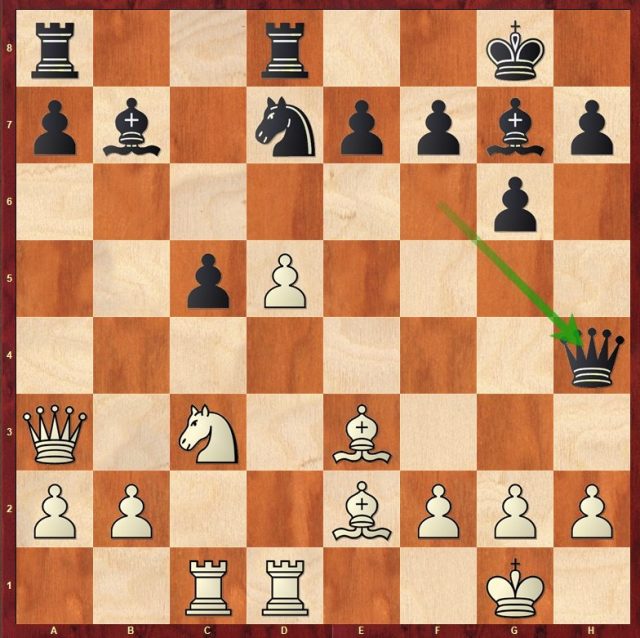
20.Bb5 [After another brainstorm, not necessarily the first choice, but very interesting]
20…Be5 [20…Qb4 21.Bc6 (21.Qxb4!? cxb4 22.Na4) 21…Qxa3 22.bxa3 Bxc3 23.Rxc3 (23.Bxb7 Rab8 should have been enough to equalize) 23…Bxc6 24.dxc6 Ne5 = (the point I missed, the threat of back rank mate allows to regain the c6 pawn and save the game); 20…Nf6!? was also very tempting, but we had to see a complex line that eluded us both; 21.Qxc5 Ng4 22.Bf4 Rdc8 23.Bc6 Be5! (23…Bxc6 24.dxc6 Rxc6 25.Qxc6 Qxf2+ 26.Kh1 Qxf4 27.Qxa8+ Bf8 28.g3 Qf2 would be nice, but unfortunately, the Queen returns to g2!) 24.Bxe5 Nxe5 and black will win back the pawn on c6; 25.Rd4? Nf3+ 26.gxf3 Qg5+-+]
21.h3 [21.g3 Qh3]
21…Bd6 [That was the idea, even though I understand that the computer doesn’t approve]
22.Bc6 [22.Bxd7 Rxd7 23.Bxc5 Be5 left some activity to black]
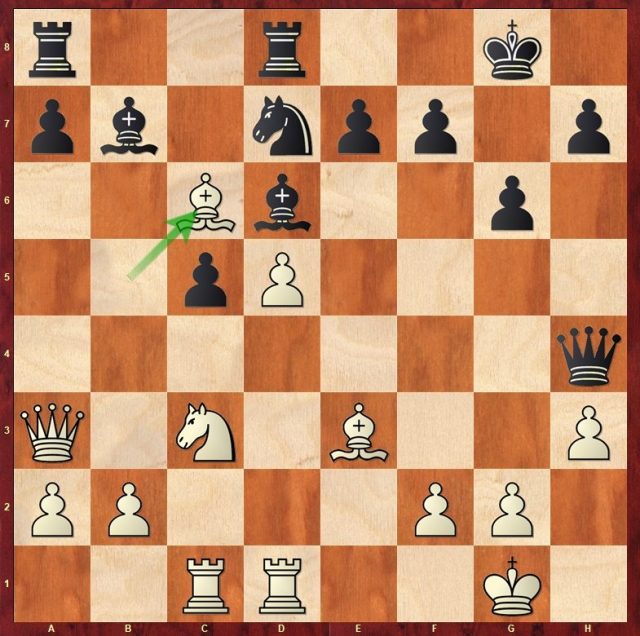
22…Bxc6 [I decided to embark on a high-risk tactical operation, not least because I hadn’t seen 22…Rab8 23.Qxa7 Bc8! (yet another return of the Bishop to its starting square!) 24.Qa4 Rb4 and black’s pieces begin to covet the King].
23.dxc6 Ne5 24.Bxc5 Nc4
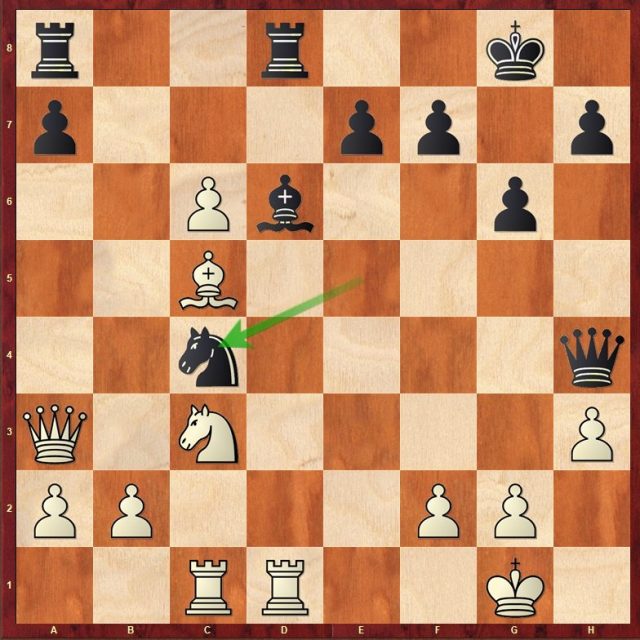
25.Qa6 [I was analyzing as a madman 25.Qb4 a5 26.Qb5 Rdb8 (26…Rab8? 27.c7! Bxc7 28.Rxd8+ Rxd8 29.Nd5+-) 27.Bxd6 (As it happens, 27.Rd4! wins but it’s such a difficult move to envisage, especially from a distance! 27…Qg5 ((27…Rxb5 28.Nxb5 Qg5 29.Rdxc4 the c6-pawn is too strong)) 28.Qxc4 Qxc1+ 29.Rd1 Qxb2 30.Bxd6 exd6 31.c7 Rc8 32.Rxd6 and the c-pawn is again too strong) 27…Rxb5 28.Bg3 Qg5 29.Nxb5 Qxb5 30.c7 Rf8 (30…Nd6 31.Bxd6 exd6 32.c8Q+ Rxc8 33.Rxc8+ Kg7 34.Rc2, white will continue with Rd4, a3 and Rcd2 winning the d6 pawn and probably the game) 31.Rd8 Nb6 32.Rb8 Kg7 (the right move order! 32…Rc8? 33.Rd1 Kg7 34.Rd8 Qc5 35.Rbxc8 Nxc8 36.Rxc8 e5 37.Re8 Qxc7 38.Bxe5++-; 32…Qxb2? 33.Bf4! and 34.Be3) 33.c8Q Rxc8 34.Rcxc8 Qxb2 and the game goes on! Given the complexity of the variations, I knew I might have missed something (in this case 27.Rd4!), but that went for my opponent too].
25…Bxc5 26.Rxd8+ Rxd8 27.c7 Rf8 [27…Qxf2+? 28.Kh1 Rd2 is totally insufficient as Queens return to defense, e.g. 29.c8Q+ Kg7 30.Qac6]
[Here, white had three plausible moves, so we had a large mass of complex variations to calculate!]
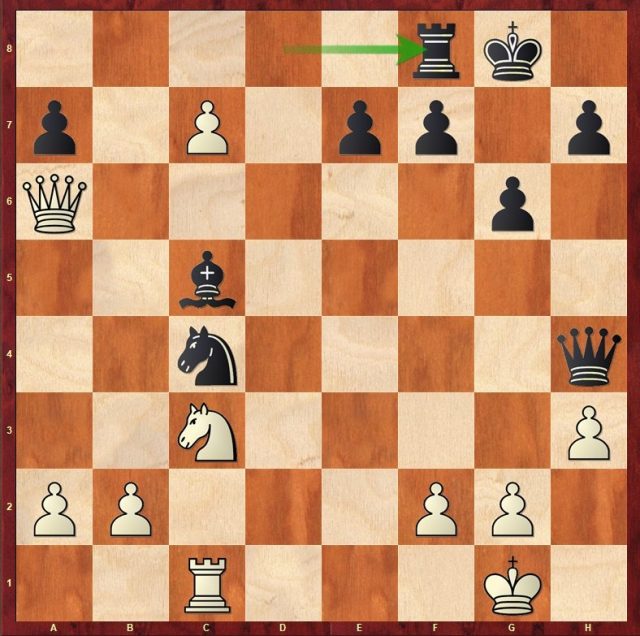
28.Ne4!? [First of all the logical 28.Nd1, which has the merit of protecting f2 while setting a skewer on black’s minor pieces on the c-file. 28…Nb6! 29.Rxc5 Qd4 30.Rc1 (30.c8Q?? Qxd1+ 31.Kh2 Qd6+ 32.g3 Nxc8) 30…Qd2 31.Ra1 Qe1+ 32.Qf1 (32.Kh2 Qe5+) 32…Qe5 33.Rc1 Rc8 34.Qd3 Nd5 35.Qb5 e6 and Black ends up capturing the c7-pawn, with equality!]. 28.c8Q! was finally the most trivial and best move; 28…Qxf2+ (28…Bxf2+? 29.Kh1 Rxc8 30.Qxc8+ Kg7 31.Ne2 ((31.Ne4? Be3; 31.Nd1? Bb6; 31.Qg4 right away was also strong)) 31…Nd6 ((31…Nxb2? 32.Qc3+ Qf6 33.Qc2)) 32.Qg4) 29.Kh1 Rxc8 30.Qxc4 Qxb2 31.Ne4 white will win a piece, but with 2 pawns and a counter-pin on the c-file, black’s situation is not yet hopeless.
28…Qxe4 29.c8Q [29.Qxc4? Bxf2+ 30.Kxf2 Qxc4 31.Rxc4 Rc8 32.b4 Kf8 33.a4 Ke8 and black wins c7 just in time].
29…Bxf2+ 30.Kh1 [30.Kxf2?? Qe3+ 31.Kf1 Nd2#]
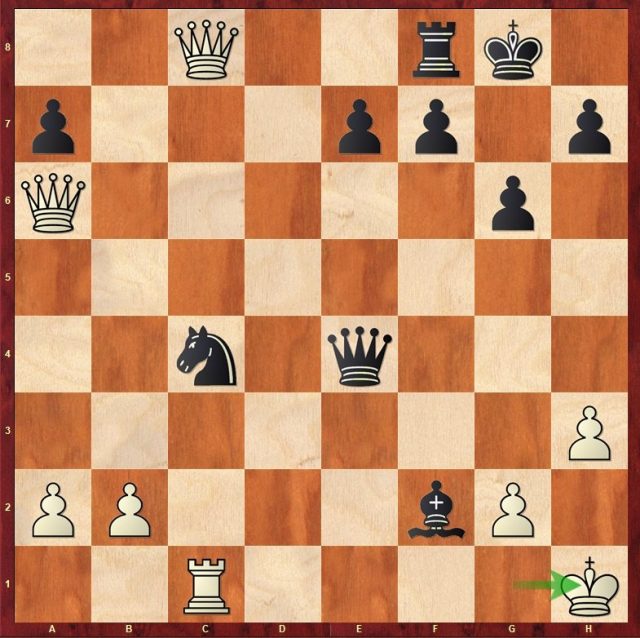
30…Ne3?! [Here I thought for a long time, but not, as many thought, because I was hesitating to play the endgame resulting from 30…Rxc8 31.Qxc8+ Kg7 32.Qxc4 Bd4 (only move, the endgame without Queens offers absolutely no hope) 33.Rd1 e5, as I wasn’t very optimistic about it. In fact, I very quickly decided to leave white with both Queens, as I realized that their joint attacking strength wouldn’t really be able to express itself in this position, and that white might not be able to force the favorable exchange of a pair of Queens. My real dilemma was to choose the Knight’s square: d6 or e3? e3 seems more natural, with more direct threats, but analysis shows that d6 was necessary to avoid an exchange of Queens, e.g. 30…Nd6! 31.Qc2 Qh4! (I had seen 31…Qf4? 32.Qae2 Bd4 33.Rf1 ((33.Qxe7? Nf5)) 33…Qh4 ((33…Qg3 34.Qcd3)) 34.Qg4) 32.Qae2 Bd4 followed by …e5]
31.Qcc6 Qd4 [31…Qf4 32.Qf3 Qxf3 33.gxf3 Nf5 34.Rc8 is hopeless in the long run because of the Queenside majority]
32.Qaa4! [White has no time to save his majority, e.g. 32.b3? Rd8! and black’s threats become very real]
32…Qxb2 33.Qb3 Qd2 [33…Qxb3 34.axb3 Nf5 would have left a better chance of establishing a fortress, because with a b3 pawn instead of a2, the Bishop would have stable access to the b6 square (no a4-a5). But at that point, I still thought I could avoid the Queens exchange!
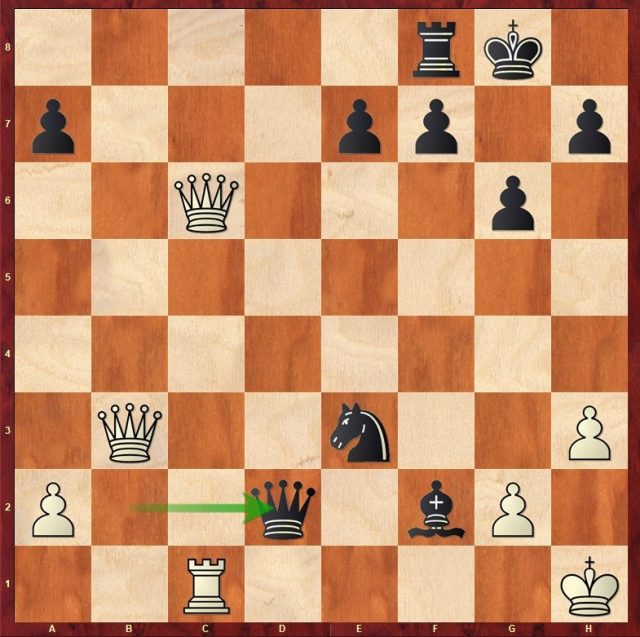
34.Qbc3? [Right square, wrong Queen! He probably forgot that after 34.Qcc3! black had to exchange Queens with 34…Qxc3 (34…Qd6? 35.Qbb2 Nd1 allowed a funny mate on g7 with an original Queens battery!) 35.Qxc3 Nf5 36.g4 Nd6 and the chances of building a fortress in this endgame are slim].
34…Qxa2 35.Qf3 [35.Ra1 Qe2 36.Qf3 Qxf3 37.gxf3 Nf5 looks like a fortress this time].
35…Nf5 36.Qc2 [tantamount to a draw proposal but there was no way to continue: 36.g4 Ng3+ 37.Kg2 Ne2 38.Qc2 Nxc1; 36.Ra1?! Ng3+ 37.Kh2 Qe6 and it’s White who has to be vigilant on the black squares around his King, e.g. 38.Ra4 (38.Qxf2? Ne4 with a rare fork on 2 Queens!; 38.Qb2 Qd6) 38…Qd6]
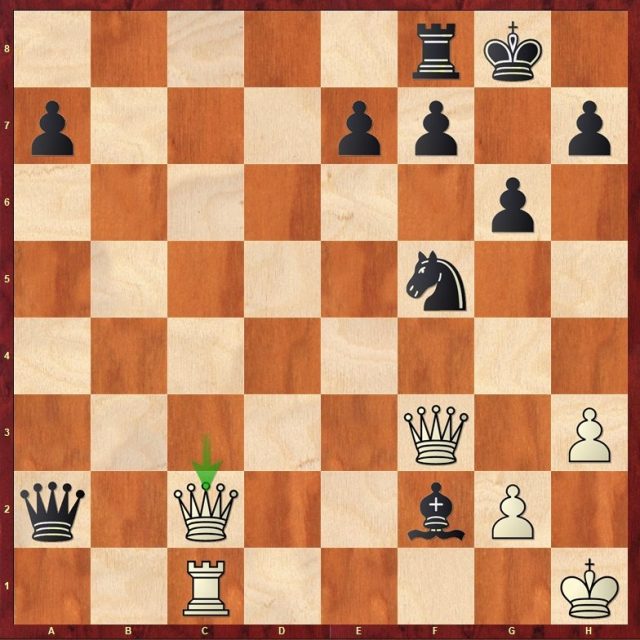
36…Ng3+ [I vaguely considered playing for the win, which I might have done in other circumstances. Indeed, after 36…Qxc2 37.Rxc2 Bg3!, the Bg3 is a permanent thorn, « grounding » white’s King. Black doesn’t care about his a-pawn and will seek to stabilize the Bg3 and then create favorable conditions for an e-pawn push, after a follow-up like 38.Qb7 h5 39.Rc8 Rxc8 40.Qxc8+ Kg7 41.Qa6 h4 42.Qxa7 e5 43.Kg1 Nd4 44.Kf1 Bf4. This is certainly objectively insufficient, and the machine shows an unflappable 0.00, but it’s definitely very tedious for white to play in practice].
37.Kh2 Nf1+ 38.Kh1 ½–½
A really spectacular game that was fun to play!
Maxime’s games in Chennai:
France is at the origin of the European Corporate Championship: this competition was created in 2016, during the 87th FIDE Congress. Open to companies located in Europe, it is played with teams of 4 players, at a time control of 15+5. Each team is allowed two players from outside the company. This year, the competition will take place in Asnières on November 22 and 23. 57 teams have signed up, including for instance the Banque de France, Google, Microsoft Europe, Dassault Systèmes, Volkswagen and the European Commission.
What does this have to do with Maxime, you may ask? Because he’ll be taking part in the competition under the colors of Leonard Echecs, which supports local authorities, clubs and companies in the design, development and animation of their chess life, and whose President, Jean-Claude Moingt, is also in charge of his French club in Asnières.
A competition not to be taken lightly, with 20 Grandmasters lining up on the entry list!

